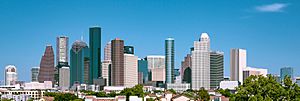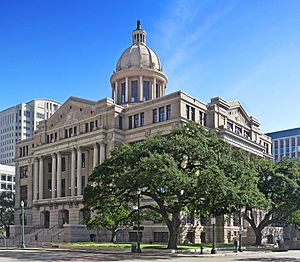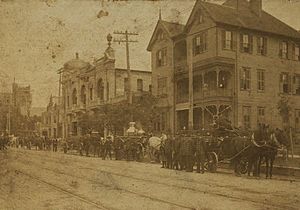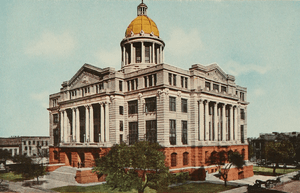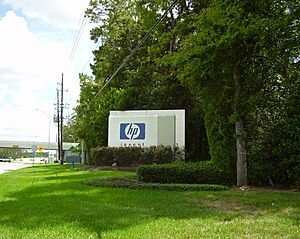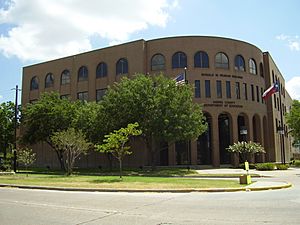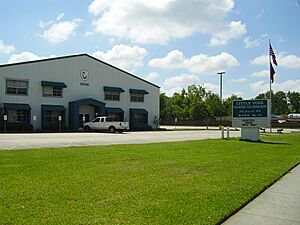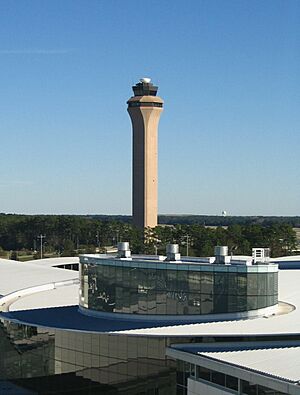Harris County, Texas facts for kids
Quick facts for kids
Harris County
|
||
|---|---|---|
|
Downtown Houston, Harris County Courthouse
|
||
|
||
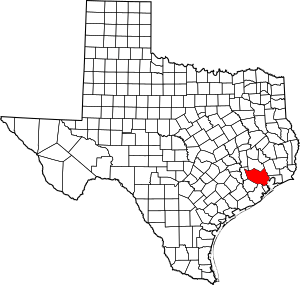
Location within the U.S. state of Texas
|
||
 Texas's location within the U.S. |
||
| Country | ||
| State | ||
| Founded | December 22, 1836 | |
| Named for | John Richardson Harris | |
| Seat | Houston | |
| Largest city | Houston | |
| Area | ||
| • Total | 1,780.26 sq mi (4,610.9 km2) | |
| • Land | 1,706.96 sq mi (4,421.0 km2) | |
| • Water | 73.30 sq mi (189.8 km2) 4.2% | |
| Population
(2020)
|
||
| • Total | 4,731,145 | |
| • Estimate
(2023)
|
4,835,125 |
|
| • Density | 2,657.558/sq mi (1,026.0891/km2) | |
| Time zone | UTC−6 (Central) | |
| • Summer (DST) | UTC−5 (CDT) | |
| Congressional districts | 2nd, 7th, 8th, 9th, 18th, 22nd, 29th, 36th, 38th | |
Harris County is a county located in the U.S. state of Texas; as of the 2020 census, the population was 4,731,145, making it the most populous county in Texas and the third-most populous county in the United States. Its county seat is Houston, the most populous city in Texas and fourth-most populous city in the United States. The county was founded in 1836 and organized in 1837. It is named for John Richardson Harris, who founded the town of Harrisburg on Buffalo Bayou in 1826. According to the July 2023 census estimate, Harris County's population has shifted to 4,835,125 comprising over 16% of Texas's population. Harris County is included in the nine-county Houston–The Woodlands–Sugar Land metropolitan statistical area, which is the fifth-most populous metropolitan area in the United States.
Contents
History
Human remains date habitation to about 4000 BC. Other evidence of humans in the area dates from about 1400 BC, 1 AD, and later in the first millennium. The region became uninhabited from 1 AD to European contact. Little European activity predates 1821. Álvar Núñez Cabeza de Vaca may have visited the area in 1529. French traders recorded passing through in the 18th century. Spaniards attempted to establish a fort in the area around the same time, but did not persist for long.
The first recorded European settlers in Harris County arrived in 1822. Their schooner sailed into Galveston Bay and ran aground on the Red Fish Bar. Some of those passengers traveled further up the bay system, but it is not known whether they settled up Buffalo Bayou or the San Jacinto River. One of these passengers, a Mr. Ryder, settled at what is now known as Morgan's Point, Texas. Also in 1822, John Iiams settled his family at Cedar Point after sailing from Berwick's Bay, Louisiana. Dr. Johnson Hunter arrived just after Iiams. He also wrecked his boat near Galveston. He settled at Morgan's Point and was a grantee of land there. Nathaniel Lynch settled in the area and operated a ferry.
In 1824, the land empresario, Stephen F. Austin convened at the house of William Scott for the purpose of conveying titles for Mexican headrights. He was joined by the land commissioner, Baron von Bastrop, and Austin's secretary, Samuel May Williams. About thirty families gained legal titles to land in what would later be known as Harris County. A few immigrants settled on Buffalo Bayou in these early years, including Moses Callahan, Ezekial Thomas, and the Vince brothers.
Nicolas Clopper arrived in the Galveston Bay area from Ohio in the 1820s. He attempted to develop Buffalo Bayou as a trading conduit for the Brazos River valley. He acquired land at Morgan's Point in 1826. John Richardson Harris (1790–1829), for whom the county was later named, arrived in 1824. Harris had moved his family to Sainte Genevieve, Missouri Territory, where they had been residing until the early 1820s.
Harris was granted a league of land (about 4,428 acres) at Buffalo Bayou. He platted the town of Harrisburg in 1826, while he established a trading post and a grist mill there. He ran boats transporting goods between New Orleans and Harrisburg until his death in the fall of 1829.
The First Congress of the Republic of Texas established Harrisburg County on December 22, 1836. The original county boundaries included Galveston Island, but were redrawn to its current configuration in May 1838.
The area has had a number of severe weather events, such as the following hurricanes and tropical storms:
Geography
According to the United States Census Bureau, the county has a total area of 1,777 square miles (4,600 km2), of which 1,703 square miles (4,410 km2) is land and 74 square miles (190 km2) (4.2%) is covered by water. Both its total area and land area are larger than the U.S. state of Rhode Island.
Adjacent counties
- Montgomery (north)
- Liberty (northeast)
- Chambers (east)
- Galveston (southeast)
- Brazoria (south)
- Fort Bend (southwest)
- Waller (northwest)
Communities
Cities
Multiple counties
- Baytown (partly in Chambers County)
- Friendswood (mostly in Galveston County)
- Houston (county seat and largest municipality) (small parts in Fort Bend and Montgomery counties)
- Katy (partly in Fort Bend, Harris, and Waller counties)
- League City (mostly in Galveston County)
- Missouri City (mostly in Fort Bend County)
- Pearland (mostly in Brazoria County and a small part in Fort Bend County)
- Seabrook (some water surface in Chambers County)
- Stafford (mostly in Fort Bend County)
- Waller (partly in Waller County)
Harris County only
- Bellaire
- Bunker Hill Village
- Deer Park
- El Lago
- Galena Park
- Hedwig Village
- Hilshire Village
- Humble
- Hunters Creek Village
- Jacinto City
- Jersey Village
- La Porte
- Morgan's Point
- Nassau Bay
- Pasadena
- Piney Point Village
- Shoreacres
- South Houston
- Southside Place
- Spring Valley Village
- Taylor Lake Village
- Tomball
- Webster
- West University Place
Unincorporated areas
Census-designated places
- Aldine
- Atascocita
- Barrett, Texas
- Channelview
- Cinco Ranch (mostly in Fort Bend County)
- Cloverleaf
- Crosby
- Highlands
- Mission Bend (mostly in Fort Bend County)
- Sheldon
- Spring
- The Woodlands (mostly in Montgomery County)
Other communities
- Alief (Partially annexed by Houston, partially unincorporated)
- Airline
- Bammel
- Barker
- Beaumont Place
- Bridgeland Community
- Cedar Bayou
- Champion Forest
- Cimarron
- Coady
- Cypress
- Dyersdale
- East Aldine
- Fall Creek
- Hockley
- Houmont Park
- Huffman
- Hufsmith
- Kinwood
- Klein
- Kleinbrook
- Kohrville
- Louetta
- Lynchburg
- McNair
- North Houston
- Northcliffe
- Northcliffe Manor
- Northgate Forest
- Remington Ranch
- Rose Hill
- Satsuma
- Traces
- Westfield
Demographics
| Historical population | |||
|---|---|---|---|
| Census | Pop. | %± | |
| 1850 | 4,668 | — | |
| 1860 | 9,070 | 94.3% | |
| 1870 | 17,375 | 91.6% | |
| 1880 | 27,985 | 61.1% | |
| 1890 | 37,249 | 33.1% | |
| 1900 | 63,786 | 71.2% | |
| 1910 | 115,693 | 81.4% | |
| 1920 | 186,667 | 61.3% | |
| 1930 | 359,328 | 92.5% | |
| 1940 | 528,961 | 47.2% | |
| 1950 | 806,701 | 52.5% | |
| 1960 | 1,243,158 | 54.1% | |
| 1970 | 1,741,912 | 40.1% | |
| 1980 | 2,409,547 | 38.3% | |
| 1990 | 2,818,199 | 17.0% | |
| 2000 | 3,400,578 | 20.7% | |
| 2010 | 4,092,459 | 20.3% | |
| 2020 | 4,731,122 | 15.6% | |
| 2023 (est.) | 4,835,125 | 18.1% | |
| U.S. Decennial Census 1850–2010 2010–2020 |
|||
2020 census
| Race / Ethnicity (NH = Non-Hispanic) | Pop 1990 | Pop 2000 | Pop 2010 | Pop 2020 | % 1990 | % 2000 | % 2010 | % 2020 |
|---|---|---|---|---|---|---|---|---|
| White alone (NH) | 1,528,113 | 1,432,264 | 1,349,646 | 1,309,593 | 54.22% | 42.12% | 32.98% | 27.68% |
| Black or African American alone (NH) | 527,964 | 619,694 | 754,258 | 885,517 | 18.73% | 18.22% | 18.43% | 18.72% |
| Native American or Alaska Native alone (NH) | 6,143 | 7,103 | 8,150 | 8,432 | 0.22% | 0.21% | 0.20% | 0.18% |
| Asian alone (NH) | 106,327 | 173,026 | 249,853 | 344,762 | 3.77% | 5.09% | 6.11% | 7.29% |
| Pacific Islander alone (NH) | N/A | 1,392 | 2,260 | 3,199 | N/A | 0.04% | 0.06% | 0.07% |
| Some Other Race alone (NH) | 4,717 | 4,499 | 7,914 | 23,262 | 0.17% | 0.13% | 0.19% | 0.49% |
| Mixed Race or Multi-Racial (NH) | N/A | 42,849 | 48,838 | 121,671 | N/A | 1.26% | 1.19% | 2.57% |
| Hispanic or Latino (any race) | 644,935 | 1,119,751 | 1,671,512 | 2,034,709 | 22.88% | 32.93% | 40.84% | 43.01% |
| Total | 2,818,199 | 3,400,578 | 4,092,459 | 4,731,145 | 100.00% | 100.00% | 100.00% | 100.00% |
As of the 2020 census, there were 4,731,145 people, 1,692,730 households, and 1,156,059 families in the county. The population density was 2,771.7 inhabitants per square mile (1,070.2/km2). There were 1,842,683 housing units. The racial makeup of the county was 38.2% White, 19.0% African American, 1.1% Native American, 7.9% Asian, 0.1% Pacific Islander, 17.7% from Some Other Races and 15.8% from two or more races. Hispanic or Latino of any race were 39.9% of the population. 25.6% of residents were under the age of 18, 6.7% were under 5 years of age, and 12.1% were 65 and older.
With a poverty rate of 15.6% as of 2020, Children At Risk—a local nonprofit research organization—estimated 21% of the Harris County children lived in poverty, 6.5 per 1,000 die before age one, and 38% drop out of high school as of 2007.
As of 2023, Harris County had the second largest population of Black Americans in the United States, behind only Cook County, Illinois. Harris also has the second largest Hispanic population in the nation, behind only Los Angeles County, California.
2010 census
As of the 2010 census, there were 4,092,459 people, 1,435,087 households, and _ families resided in the county. The population density was 2,402.4 inhabitants per square mile (927.6/km2). There were 1,598,613 housing units. The racial makeup of the county was 58.3% White, 18.8% African American, 0.6% Native American, 6.7% Asian, 0.1% Pacific Islander, 12.9% from Some Other Races and 2.6% from two or more races. Hispanic or Latino of any race were 36.8% of the population.
Language
In 2000, 1,961,993 residents of Harris County spoke English only. The five most spoken foreign languages in the county were Spanish or Spanish Creole (1,106,883 speakers), Vietnamese (53,311), Chinese (33,003), French including Louisiana French and Patois (33,003), and Urdu (14,595). Among these groups, 46% of Spanish speakers, 37% of Vietnamese speakers, 50% of Chinese speakers, 85% of French speakers, and 72% of Urdu speakers said that they spoke English at least "very well".
In 2020, 55.6% of the county aged five and older spoke English only, while 44.4% spoke another language at home, alone or together with English; Spanish remained the second most spoken language (35%).
Religion
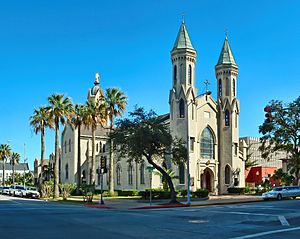
In 2010 statistics, the largest religious group in Harris County was the Roman Catholic Archdiocese of Galveston–Houston, with 1,947,223 Catholics worshiping at 109 parishes, followed by 579,759 Southern Baptists with 811 congregations, 348,461 non-denominational Christian adherents with 577 congregations, 182,624 United Methodists with 124 congregations, an estimated 117,148 Muslims with 47 congregations, 44,472 LDS Mormons with 77 congregations, 39,041 Episcopalians with 43 congregations, 34,957 PC-USA Presbyterians with 49 congregations, 33,525 Churches of Christ Christians with 124 congregations, and 30,521 LCMS Lutherans with 46 congregations. Altogether, 58.4% of the population was claimed as members by religious congregations, although members of historically African-American denominations were underrepresented due to incomplete information. In 2014, the county had 1,607 religious organizations, the third most out of all U.S. counties.
Administration by judiciary
The chief administrative officer of a Texas County, as set up in the Texas Constitution, is the County Judge, who sits as the chair of the county's Commissioners' Court (the equivalent of a Board of Supervisors in some other states). In 2019, Judge Lina Hidalgo was sworn in as the County Judge. The county is split into four geographical divisions called precincts. Each precinct elects a Commissioner to represent them on the commissioners court and oversee county government functions in the precinct.
Other elected positions in Harris County include a County Attorney, a County Clerk, a District Attorney, a District Clerk, a Sheriff, eight Constables, a Tax Assessor-Collector, a County Treasurer, and every judge in the county except municipal judges, who are appointed by the mayors and confirmed by city councils of their respective cities.
Many of the organs of the Harris County government reside in the Harris County Campus in Downtown Houston.
Economy
In 2000, the largest employers in Harris County were Administaff, Compaq, Continental Airlines, Memorial Hermann Healthcare System, and Southwestern Bell.
The University of Houston System's annual impact on the Houston-area's economy as of 2011 equates to that of a major corporation: $1.1 billion in new funds attracted annually to the Houston area, $3.13 billion in total economic benefit, and 24,000 local jobs generated. This is in addition to the over 12,500 new graduates the UH System produces every year who enter the workforce in Houston and throughout Texas. These degree-holders tend to stay in Houston; after five years, 80.5% of graduates are still living and working in the region.
In 2009, 20% of the office space in northwest Harris County was vacant. As of that year, more office space was being built; in 2010, northwest Harris will have twice the amount of office space that it had in 2009. The vacancy rate in the area near Farm to Market Road 1960 and Texas State Highway 249 in north Harris County was 53% in 2009.
Various companies are headquartered in incorporated and unincorporated areas throughout Harris County.
Academy Sports and Outdoors, a sporting goods retailer, has its corporate offices and product distribution center in unincorporated western Harris County. Hewlett-Packard formerly operated its United States region office in a complex northwest unincorporated Harris County; the complex formerly belonged to Compaq prior to Compaq's merger with HP. The HP offices, which are now occupied by Hewlett Packard Enterprise, are now in a limited purpose annexation in Houston. Smith International has its headquarters in the Greenspoint district and in an unincorporated area in Harris County. BJ Services Company has its headquarters in the Spring Branch district and in unincorporated Harris County. Cybersoft Technologies has its headquarters in an unincorporated area. In 2012, Noble Energy announced that it was consolidating its headquarters and two other Greater Houston offices into a 10-story building on the former Compaq headquarters property in unincorporated Harris County. In 2022, ExxonMobil announced it was moving its headquarters to Harris County from Irving, Texas. Goya Foods previously had its Texas offices in an unincorporated area in the county.
General Electric operates an aeroderivative division facility on Jacintoport in unincorporated Harris County. Randall's Food Markets, a subsidiary of Safeway Inc., has its distribution center in unincorporated Harris County.
In 2008, KBR announced that it will open a new office facility in an unincorporated area in western Harris County. In December KBR said that it would not continue with the plans due to a weakened economy. In January 2009 KBR announced that it will not open the new office facility.
Education
Primary and secondary schools
The Harris County Department of Education, a county division overseeing education by local school districts, with a 2011 budget around $100 million, is headquartered in the Ronald W. Reagan Building in the Northside district in Houston. It has an Adult Education Center in the Northside and an office in the North Post Oak Building in Spring Branch.
Several school districts serve Harris County communities. Among the 26 districts are:
|
|
|
On July 1, 2013, the North Forest Independent School District closed and its territory became a part of Houston ISD.
In addition, state-operated charter schools are in the county. Charter schools in unincorporated areas include:
- Jamie's House Charter School (6–12)
- Richard Milburn Academy Houston (high school) – Of Milburn Schools
- YES Prep North Central of YES Prep Public Schools
The department of education of the county operates the Highpoint Schools.
Colleges and universities
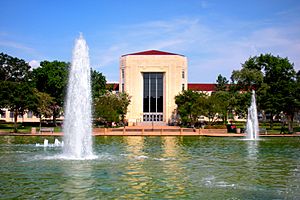
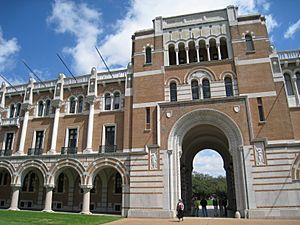
Four separate and distinct state universities are located in Harris County. The University of Houston is a nationally recognized Tier One research university, and is the flagship institution of the University of Houston System. The third-largest university in Texas, the University of Houston counted 43,774 (fall 2016) students on its 667-acre campus in southeast Houston. The University of Houston–Clear Lake and the University of Houston–Downtown are stand-alone universities; they are not branch campuses of the University of Houston. Located in the historic community of Third Ward is Texas Southern University, one of the largest historically black colleges and universities in the United States.
Several private institutions of higher learning—ranging from liberal arts colleges to a nationally recognized research university—are located within Harris County. Rice University is one of the leading teaching and research universities of the United States and ranked the nation's 17th best overall university by U.S. News & World Report.
Five community college districts exist with campuses in and around Harris County:
- The Houston Community College System serves Houston ISD (including the former North Forest ISD), Katy ISD, Spring Branch ISD, Alief ISD, and Stafford MSD. This includes most of the City of Houston.
- The Lone Star College System (formerly North-Harris Montgomery Community College District) serves Aldine ISD, Cypress-Fairbanks ISD, Tomball ISD, Humble ISD, and Klein ISD. This constitutes the northwestern through northeastern parts of the county.
- San Jacinto College serves Pasadena ISD, Galena Park ISD, Sheldon ISD, Channelview ISD, Deer Park ISD, La Porte ISD, and the Harris County part of Clear Creek ISD. This constitutes southeastern and eastern portions of the county
- Lee College serves Goose Creek ISD, Crosby ISD, and Huffman ISD, far east to northeast sections
- Blinn College is the community college for portions of Waller ISD in Harris County, far northwestern parts.
The Houston Community College and Lone Star College systems are within the 10 largest institutions of higher learning in the United States.
Public libraries
Harris County operates its own public library system, the Harris County Public Library.
In addition, Houston has the Houston Public Library, a city-controlled public library system.
The cities of Baytown, Bellaire, Deer Park, and Pasadena have their own city-controlled libraries.
Emergency services
Police services
Incorporated cities operate their own police departments, though Harris County operates the Harris County Sheriff's Office, which serves unincorporated areas and supplements police forces of incorporated areas.
Harris County also has a constable for each of its eight precincts and hundreds of deputies assigned to each. They mainly serve in a patrol function, established to maintain peace in the county as well as providing security to county buildings such as court houses and district attorney's offices.
Municipal fire/EMS services
The Harris County Fire Marshal's Office operates an Investigative Branch, an Emergency Response Branch (Hazardous Materials Response) and Prevention Branch (Inspections). The office is headquartered at 2318 Atascocita Road in an unincorporated area. Incorporated cities operate their own fire departments. The city of Houston operates the Houston Fire Department which provides fire and emergency medical coverage to the city of Houston.
Emergency services districts
Areas outside of municipal city limits (and some smaller municipalities) have fire and emergency medical services provided by Emergency Service Districts, distinct governmental units with the ability to levy property and sales taxes. ESD's may provide fire service, EMS service or both (dual services) and the services they provide determine the limits on their adoptable tax rate.
ESD's may provide services directly or may contract with an agency or agencies for services. ESD's may overlap one another to ensure both fire and EMS services are provided.
| ESD | Type | Provider | Sales Tax Rate (2015) | Property Tax Rate per $100 Valuation (2015) |
|---|---|---|---|---|
| Harris County ESD #1 | EMS | Harris County Emergency Corps | .10 | |
| Harris County ESD #2 | EMS | South Lake Houston EMS | 1% | .0280120 |
| Harris County ESD #4 (4A) | Dual | Huffman FD | 1% (2%) | .10 (.10) |
| Harris County ESD #5 | EMS | HCESD5 EMS | 1% | .02 |
| Harris County ESD #6 | EMS | North Channel EMS | .5% | .0089 |
| Harris County ESD #7 | Fire | Spring VFD | 1% | .06545 |
| Harris County ESD #8 | EMS | Northwest EMS | .10 | |
| Harris County ESD #9 | Dual | Cy-Fair FD | 1% | .055 |
| Harris County ESD #10 | Fire | Eastex Fire Department | 1% | .10 |
| Harris County ESD #11 | EMS | https://esd11.com/ | .04185 | |
| Harris County ESD #12 | Fire | Cloverleaf Fire Department | .5% | .03 |
| Harris County ESD #13 | Fire | Cypress Creek FD | .08826 | |
| Harris County ESD #14 | Dual | Highlands VFD | 2% | .05 |
| Harris County ESD #15 | Fire | Tomball FD | 1% | .05 |
| Harris County ESD #16 | Fire | Klein VFD | 1% | .05 |
| Harris County ESD #17 | Fire | Little York VFD | 1% | .10 |
| Harris County ESD #19 | Fire | Sheldon VFD | .03 | |
| Harris County ESD #20 | Fire | Northwest FD | 1% | .10 |
| Harris County ESD #21 | Dual | Rosehill FD | 1% | .10 |
| Harris County ESD #24 | Fire | Aldine Fire & Rescue | .10 | |
| Harris County ESD #25 | Fire | Westfield FD | .10 | |
| Harris County ESD #28 | Fire | Ponderosa VFD | 1% | .10 |
| Harris County ESD #29 | Fire | Champions FD | 1% | .09032 |
| Harris County ESD #46 | Dual | Atascocita VFD | 1% | .08 |
| Harris County ESD #47 | Dual | Westlake FD | 1% | .095186 |
| Harris County ESD #48 | Dual | HCESD48 FD | 1% | .089 |
| Harris County ESD #50 | Dual | Channelview FD | 1% | .05 |
| Harris County ESD #60 | Fire | Sheldon VFD | 1% | .05 |
| Harris County ESD #75 | Dual | Baytown FD | 1% | .0875 |
| Harris County ESD #80 | Fire | Crosby FD | 1% | .04178 |
| Harris-Fort Bend ESD #100 | Dual | Community FD | 1% | .07951 |
| Waller-Harris ESD #200 | Other | Multiple Fire/EMS Agencies | .0995 |
Hospital services
Within Harris County, hospital services for the indigent and needy are provided by the Harris Health System (Harris County Hospital District), a separate governmental entity. Harris Health System operates two hospitals: LBJ General Hospital and Ben Taub General Hospital, as well as many clinics and the former Quentin Mease Community Hospital.
Numerous private and public hospitals operate in Harris County, including institutions in Texas Medical Center and throughout the county, for example the Harris County Psychiatric Center.
Transportation
Metropolitan Transit Authority of Harris County, Texas (METRO) serves several areas within Harris County. An agency of the Harris County government, Harris County Transit, serves communities in Harris County that are not served by METRO.
In Harris County, the average one way commute for a person using an automobile was 25 minutes, while the average commute for a person not using an automobile was 44 minutes, a 76% longer duration than the figure for commuters with cars.
Major highways
|
|
Mass transit
Many areas in Harris County are served by Metropolitan Transit Authority of Harris County, Texas (METRO), a public transportation agency headquartered in Downtown Houston.
Some communities outside of METRO's service area, such as Baytown, Texas, and Channelview, Texas, are served by Harris County Transit.
Intercity buses
Greyhound Bus Lines operates various stations throughout Harris County.
Airports
Two commercial airports, George Bush Intercontinental Airport and William P. Hobby Airport, are located in Houston and in Harris County. The Houston Airport System defines Harris County as a part of Bush Intercontinental's service region. The city of Houston operates Ellington Field, a general aviation and military airport in Harris County.
General aviation airports for fixed-wing aircraft outside of Houston include:
- Publicly owned
- Privately owned, public use
- West Houston Airport is a general aviation airport located in unincorporated western Harris County, west of the Houston city limits.
- Dan Jones International Airport in unincorporated northwestern Harris County
- Weiser Air Park in unincorporated northern Harris County
- David Wayne Hooks Memorial Airport, a general aviation airport, is located outside of the Tomball city limits in unincorporated northwest Harris County.
- Sack-O-Grande Acroport (also known as Harbican Airport) is located in western unincorporated Harris County.
- Privately owned, private use
- Hoffpauir Airport is located in western unincorporated Harris County.
See also
 In Spanish: Condado de Harris (Texas) para niños
In Spanish: Condado de Harris (Texas) para niños


